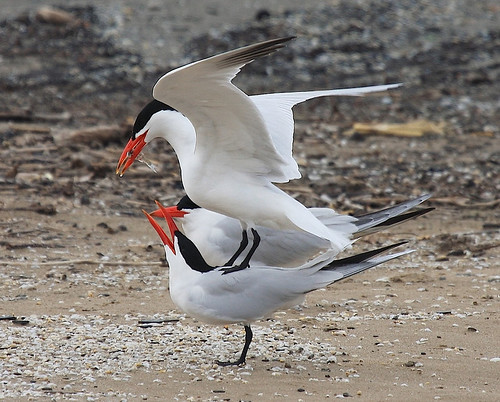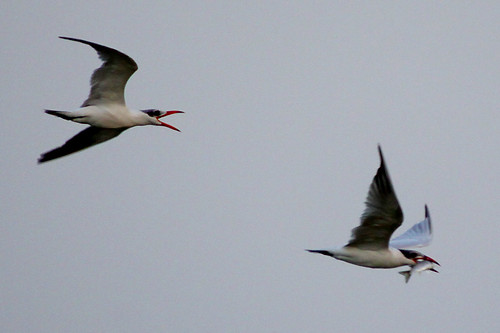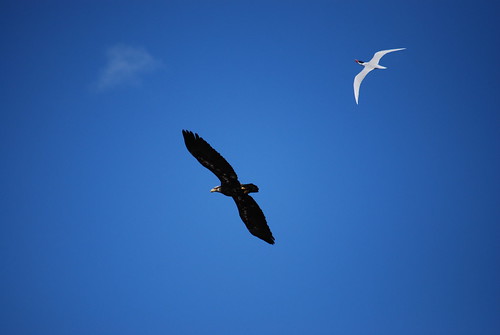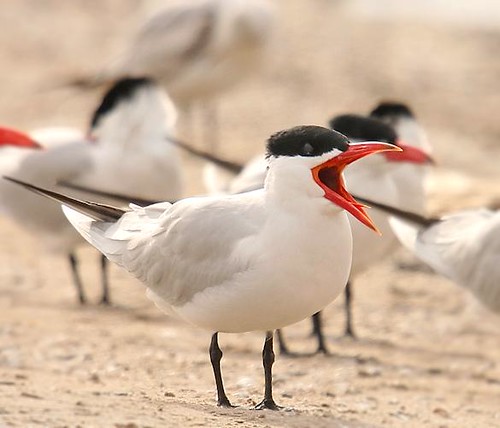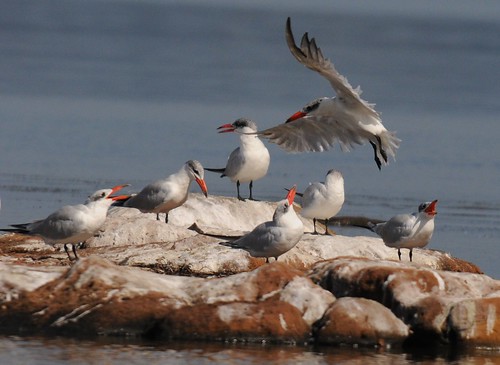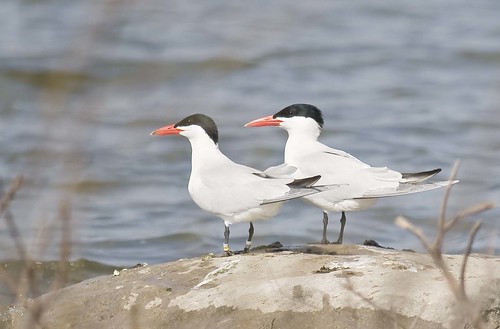This is fine photo of a Caspian Tern, but it is blog-worthy because of where and when the photography captured this shot. In late May Caspian Terns that are going to initiate breeding in western North America are still wandering around in small numbers, but most are on eggs by now and the first chicks are not far away. This Caspian Tern is 378 miles south from the Copper River delta which has breeders and is then 860 miles north of the colony at Dungeness Spit, Washington. If it was carrying fish in mid June, this would be HIGHLY suspicious breeding activity.
Saturday, May 30, 2009
Wednesday, May 27, 2009
Food and Sex
This photo is a wonderful profile of the behaviors immediately preceding copulation in Caspian Terns. The male is balancing on top of the female's back with a small cyprinid (6-7 cm) long in his bill. The female is not quite in the lordotic curvature (fully swayed back with raised tail) that will allow the male to turn his tern tail under hers in order to make the 'cloacal kiss' necessary to transfer gametes. It almost certain the female is making a highly pitched call reminiscent of a chick begging for food. Often copulation follows soon after (<10 secs) the female takes the fish, but I have seen females take the fish and then dump the male and males that eaten the fish after a cop.
What happened to sharing??!!
Of the many wonderful things about science vocabulary is that the best term describe what is happening in this potentially ... bad tern of events is "PIRACY!" Piracy is whenever intraspecific stealing of food occurs and is a regular part of the behavior of small percentage of Caspian Terns, especially when the fish are large and conspicuous like this one.
Thursday, May 21, 2009
Caspian Terns in Kuwait
These Caspian Terns in Kuwait (29.31722, 47.87222) are in what reminds me of post-breeding habitat in Mexico's western coast. The photo is fascinating to me because it shows 7 adults in breeding plumage and then the tern second from the left is a young of the year. The tern to its right also appears to be a youngster, but could be an adult moulting into non-breeding plumage. I would guess these birds bred in eastern Africa between November and February before migrating north, but it is only a guess. The Far eastern curlews are probably heading north to breed, so it is a very interesting mix of birds indeed.
Ron Johnstone & John Darnell of the Western Australian Museum
Ron Johnstone, Curator of Ornithology, and John Darnell, Research Associate, of the Western Australian Museum of Science & Culture show off a drawer of 3 Caspian Terns in the research collections. They shared an amazing amount of insight about the distribution and behavior of terns in general and Caspians specifically during an afternoon visit by David Craig and Erik Willis of Willamette University.
Wednesday, May 13, 2009
Immature Baldy chased by Caspian
This shot shows the huge attitude Caspian Terns have and the attention they give to potential predators like Bald Eagles. This photo as one of few by Ben Retlin taken on the bay side of the Bayocean Spit which comprises the western border of the Tillamook Bay in Oregon. They were taken on April 30, 2009.
Tuesday, May 12, 2009
Caspian Terns and Nictitating
This Caspian Terns appears to yawning and is caught in a moment with it is blinking its nictitating membrane, but not its eye-lid.
I have found the secret resting place of the Caspian Terns!!!
Caspian Terns do seem to have spots they like to loaf at that are discrete from other waterbirds if they get the chance to use them. In Mexico and Australia I have found they are much more common in the freshwater parts of estuaries.
Sunday, May 3, 2009
Banded Caspian in Bloomingdale, Ontario
This Caspian Tern was probably marked as part of the historical research in Hamilton Harbour. The work in Lake Ontario has included some very innovative efforts to promote the coexistence of Caspian Terns and urban development.
Caspian Tern Nesting Raft
http://www.science.mcmaster.ca/Biology/Harbour/RESTOR/CASPIAN.HTM
Lampman K., Taylor M. & Blokpoel H. (1996) Caspian terns (Sterna caspia) breed successfully on a nesting raft. Waterbirds, 19, 135–138
James S. Quinn and Jane Sirdevan "Experimental measurement of nesting substrate preference in Caspian terns, Sterna caspia, and the successful colonisation of human constructed islands" in Biological Conservation
Volume 85, Issues 1-2, July-August 1998, Pages 63-68

